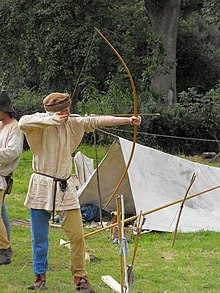Potential energy
| Potential energy | |
|---|---|

In the case of a bow and arrow, when the archer does work on the bow, drawing the string back, some of the chemical energy of the archer's body is transformed into elastic potential energy in the bent limbs of the bow. When the string is released, the force between the string and the arrow does work on the arrow. Thus, the potential energy in the bow limbs is transformed into the kinetic energy of the arrow as it takes flight.
|
|
|
Common symbols
|
PE, U, or V |
| SI unit | joule (J) |
|
Derivations from
other quantities |
U = m · g · h (gravitational) |
U = m · g · h (gravitational)
U = ½ · k · x2 (elastic)
U = ½ · C · V2 (electric)
In physics, potential energy is energy possessed by a body by virtue of its position relative to others, stresses within itself, electric charge, and other factors. Common types include the gravitational potential energy of an object that depends on its mass and its distance from the center of mass of another object, the elastic potential energy of an extended spring, and the electric potential energy of an electric charge in an electric field. The unit for energy in the International System of Units (SI) is the joule, which has the symbol J.
The term potential energy was introduced by the 19th century Scottish engineer and physicist William Rankine, although it has links to Greek philosopher Aristotle's concept of potentiality. Potential energy is associated with forces that act on a body in a way that the total work done by these forces on the body depends only on the initial and final positions of the body in space. These forces, that are called potential forces, can be represented at every point in space by vectors expressed as gradients of a certain scalar function called potential.
...
Wikipedia
